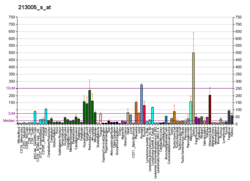ANKRD15
KN motif and ankyrin repeat domain-containing protein 1 is a protein that in humans is encoded by the KANK1 gene.[5][6][7]
This gene encodes a protein containing four ankyrin repeat domains in its C-terminus. The suggested role for this protein is in tumorigenesis of renal cell carcinoma. Two alternatively spliced transcript variants encoding different isoforms have been identified.[7]
References
- GRCh38: Ensembl release 89: ENSG00000107104 - Ensembl, May 2017
- GRCm38: Ensembl release 89: ENSMUSG00000032702 - Ensembl, May 2017
- "Human PubMed Reference:". National Center for Biotechnology Information, U.S. National Library of Medicine.
- "Mouse PubMed Reference:". National Center for Biotechnology Information, U.S. National Library of Medicine.
- Sarkar S, Roy BC, Hatano N, Aoyagi T, Gohji K, Kiyama R (Sep 2002). "A novel ankyrin repeat-containing gene (Kank) located at 9p24 is a growth suppressor of renal cell carcinoma". J Biol Chem. 277 (39): 36585–91. doi:10.1074/jbc.M204244200. PMID 12133830.
- Zhu Y, Kakinuma N, Wang Y, Kiyama R (Jan 2008). "Kank proteins: a new family of ankyrin-repeat domain-containing proteins". Biochim Biophys Acta. 1780 (2): 128–33. doi:10.1016/j.bbagen.2007.09.017. PMID 17996375.
- "Entrez Gene: ANKRD15 ankyrin repeat domain 15".
External links
- Human KANK1 genome location and KANK1 gene details page in the UCSC Genome Browser.
Further reading
- Nagase T, Seki N, Ishikawa K, et al. (1996). "Prediction of the coding sequences of unidentified human genes. V. The coding sequences of 40 new genes (KIAA0161-KIAA0200) deduced by analysis of cDNA clones from human cell line KG-1". DNA Res. 3 (1): 17–24. doi:10.1093/dnares/3.1.17. PMID 8724849.
- Strausberg RL, Feingold EA, Grouse LH, et al. (2003). "Generation and initial analysis of more than 15,000 full-length human and mouse cDNA sequences". Proc. Natl. Acad. Sci. U.S.A. 99 (26): 16899–903. doi:10.1073/pnas.242603899. PMC 139241. PMID 12477932.
- Humphray SJ, Oliver K, Hunt AR, et al. (2004). "DNA sequence and analysis of human chromosome 9". Nature. 429 (6990): 369–74. doi:10.1038/nature02465. PMC 2734081. PMID 15164053.
- Colland F, Jacq X, Trouplin V, et al. (2004). "Functional Proteomics Mapping of a Human Signaling Pathway". Genome Res. 14 (7): 1324–32. doi:10.1101/gr.2334104. PMC 442148. PMID 15231748.
- Gerhard DS, Wagner L, Feingold EA, et al. (2004). "The Status, Quality, and Expansion of the NIH Full-Length cDNA Project: The Mammalian Gene Collection (MGC)". Genome Res. 14 (10B): 2121–7. doi:10.1101/gr.2596504. PMC 528928. PMID 15489334.
- Roy BC, Aoyagi T, Sarkar S, et al. (2005). "Pathological characterization of Kank in renal cell carcinoma". Exp. Mol. Pathol. 78 (1): 41–8. doi:10.1016/j.yexmp.2004.08.012. PMID 15596059.
- Wang Y, Onishi Y, Kakinuma N, et al. (2005). "Alternative splicing of the human Kank gene produces two types of Kank protein". Biochem. Biophys. Res. Commun. 330 (4): 1247–53. doi:10.1016/j.bbrc.2005.03.106. PMID 15823577.
- Wang Y, Kakinuma N, Zhu Y, Kiyama R (2007). "Nucleo-cytoplasmic shuttling of human Kank protein accompanies intracellular translocation of beta-catenin". J. Cell Sci. 119 (Pt 19): 4002–10. doi:10.1242/jcs.03169. PMID 16968744.
This article is issued from Wikipedia. The text is licensed under Creative Commons - Attribution - Sharealike. Additional terms may apply for the media files.




